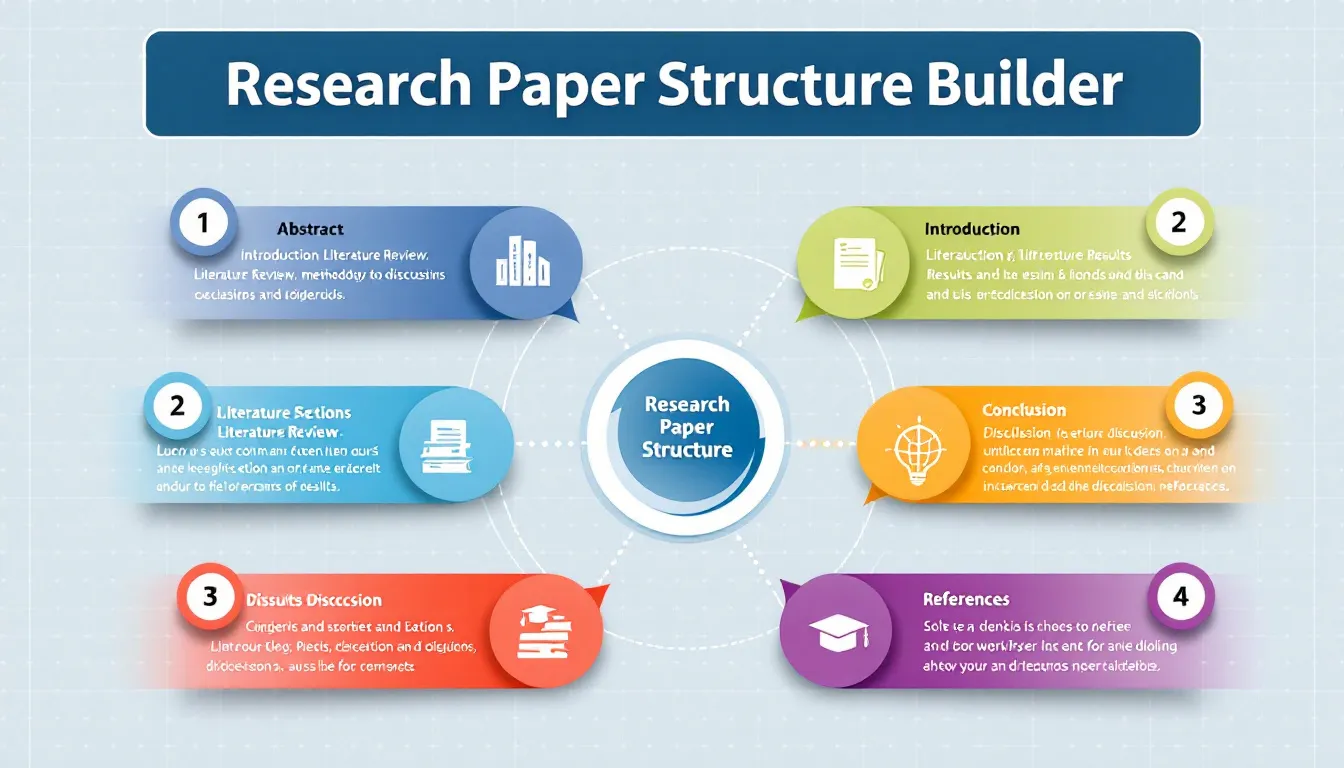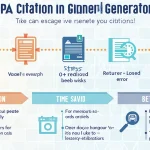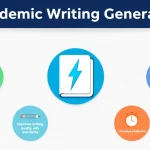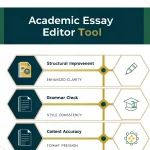Research Paper Structure Builder
Is this tool helpful?
How to Use the Research Paper Structure Builder Effectively
Step-by-Step Guide
Follow these steps to make the most of the Research Paper Structure Builder:
- Field of study: Enter your academic discipline (e.g., “Cognitive Neuroscience” or “Environmental Engineering”).
- Type of paper: Specify the paper type (e.g., “Empirical Research Paper” or “Systematic Literature Review”).
- Citation style: Choose your preferred citation style (e.g., “APA 7th Edition” or “IEEE”).
- Research methodology: Select the methodology type (e.g., “Mixed Methods” or “Meta-Analysis”).
- Total word count: Input the desired word count for your paper (optional, e.g., “5000” or “10000”).
- Research topic: Provide a brief description of your research topic or question.
- Click “Generate Research Paper Structure” to receive your customized outline.
Tips for Optimal Results
- Be specific when entering your field of study to receive more tailored guidance.
- If your paper type isn’t listed, choose the closest match or a general research paper option.
- Consider your institution’s guidelines when selecting a citation style.
- For complex topics, provide a concise yet comprehensive description of your research question.
Transforming Research into Well-Structured Academic Papers
The Research Paper Structure Builder is an innovative online tool designed to assist students, researchers, and academics in organizing their research into coherent, well-structured papers. By providing customized outlines, section-by-section guidance, and methodology frameworks, this tool streamlines the often daunting process of structuring academic work across various disciplines.
Purpose and Benefits
The primary purpose of this tool is to offer a tailored roadmap for academic writing, ensuring that researchers can focus on content rather than struggling with the paper’s structure. Key benefits include:
- Time-saving by automating the outline creation process
- Ensuring comprehensive coverage of all necessary sections
- Adapting to specific academic disciplines and paper types
- Providing guidance on appropriate methodologies
- Offering citation placeholders to encourage proper referencing
Maximizing the Benefits of the Research Paper Structure Builder
1. Tailored Outlines for Enhanced Focus
By generating discipline-specific outlines, the tool allows researchers to concentrate on content development rather than structural concerns. This tailored approach ensures that no crucial sections are overlooked, leading to more comprehensive and well-organized papers.
2. Methodology Guidance for Rigorous Research
The tool’s methodology frameworks provide a solid foundation for research design, helping users select and describe appropriate methods for their studies. This guidance is particularly beneficial for novice researchers or those exploring new methodological approaches.
3. Citation Integration for Academic Integrity
With citation placeholders and style-specific formatting, the tool promotes proper referencing practices from the outset. This feature not only saves time but also instills good habits in academic writing and reduces the risk of unintentional plagiarism.
4. Adaptability Across Disciplines
The Research Paper Structure Builder’s versatility allows it to cater to a wide range of academic fields, from humanities to hard sciences. This adaptability makes it an invaluable resource for interdisciplinary research or for institutions serving diverse academic communities.
5. Word Count Allocation for Balanced Writing
By suggesting word counts for each section based on the total paper length, the tool helps users maintain appropriate proportions throughout their work. This feature is particularly useful for managing large-scale projects like theses or dissertations.
Addressing User Needs and Solving Specific Problems
Overcoming Writer’s Block
Many researchers face writer’s block when confronted with a blank page. The Research Paper Structure Builder addresses this by providing a clear starting point and roadmap for the writing process. By breaking down the paper into manageable sections, it reduces the intimidation factor of large writing projects.
Ensuring Comprehensive Coverage
Inexperienced writers often struggle with including all necessary components in their papers. The tool solves this by generating comprehensive outlines that include all standard sections required for specific paper types and disciplines.
Adapting to Different Paper Types
The tool’s ability to adjust its output based on the selected paper type (e.g., research paper, literature review, case study) ensures that users receive relevant guidance regardless of their specific writing task. This adaptability is crucial in academic environments where various types of papers are required.
Streamlining the Research Process
By providing a clear structure from the outset, the tool helps researchers plan their work more effectively. This streamlined approach can lead to more efficient literature reviews, more focused data collection, and more coherent analysis and discussion sections.
Example Calculation: Word Count Allocation
Let’s consider a research paper in Psychology with a total word count of 8000 words. The Research Paper Structure Builder might allocate words as follows:
$$\text{SectionWordCount}_i = \text{TotalWordCount} \times \text{SectionPercentage}_i$$- Abstract: 8000 × 2% = 160 words
- Introduction: 8000 × 10% = 800 words
- Literature Review: 8000 × 25% = 2000 words
- Methodology: 8000 × 15% = 1200 words
- Results: 8000 × 20% = 1600 words
- Discussion: 8000 × 20% = 1600 words
- Conclusion: 8000 × 5% = 400 words
- References: 8000 × 3% = 240 words
This allocation provides a balanced structure while allowing flexibility for the specific needs of the research topic.
Practical Applications and Use Cases
1. Graduate Thesis Preparation
A doctoral candidate in Environmental Science could use the tool to structure a 50,000-word dissertation on climate change impacts. The generated outline would include sections like:
- Abstract
- Introduction (Problem statement, research questions, hypotheses)
- Literature Review (Climate models, previous impact studies)
- Methodology (Data collection methods, statistical analyses)
- Results (Climate projections, impact assessments)
- Discussion (Implications for policy and adaptation strategies)
- Conclusion
- References
The tool would provide word count suggestions for each section, ensuring a balanced and comprehensive thesis structure.
2. Undergraduate Research Paper
An undergraduate student in Psychology could use the tool to structure a 3,000-word research paper on the effects of social media on mental health. The outline might include:
- Introduction (Background on social media usage and mental health concerns)
- Literature Review (Previous studies on social media and mental health)
- Methodology (Survey design, participant recruitment, data analysis methods)
- Results (Statistical findings from the survey)
- Discussion (Interpretation of results, comparison with previous studies)
- Conclusion (Summary of findings, implications, future research directions)
The tool would also provide APA citation placeholders throughout the outline, ensuring proper referencing from the start.
3. Interdisciplinary Research Project
Researchers working on an interdisciplinary project combining Computer Science and Linguistics could use the tool to structure a paper on natural language processing in multilingual contexts. The outline might integrate elements from both fields:
- Abstract
- Introduction (Importance of multilingual NLP)
- Background (Linguistic theories of language acquisition, computational models of language)
- Methodology (Corpus selection, algorithm development, evaluation metrics)
- Results (Performance across different languages, error analysis)
- Discussion (Implications for both linguistics and computer science)
- Conclusion
The tool would help balance the content between the two disciplines and suggest appropriate methodological frameworks for this interdisciplinary approach.
Frequently Asked Questions (FAQ)
Q1: Can I use this tool for any academic discipline?
A1: Yes, the Research Paper Structure Builder is designed to accommodate a wide range of academic disciplines. Whether you’re working in the humanities, sciences, social sciences, or any other field, the tool can generate a tailored outline for your specific needs.
Q2: How does the tool determine the appropriate structure for my paper?
A2: The tool uses a combination of your inputs, including the academic discipline, paper type, and research methodology, to generate a customized structure. It draws from established academic writing conventions and best practices specific to your field of study.
Q3: Can I modify the generated outline?
A3: Absolutely! The generated outline serves as a starting point. You’re encouraged to adapt and refine it to best suit your specific research needs and any particular requirements from your institution or publication venue.
Q4: Does the tool provide guidance on content for each section?
A4: Yes, the tool offers general guidance on what to include in each section. However, the specific content will depend on your research. Use the guidance as a framework to develop your own ideas and findings.
Q5: How often is the tool updated with new academic standards?
A5: The Research Paper Structure Builder is regularly updated to reflect current academic standards and practices. However, always cross-reference with your institution’s specific guidelines and the latest edition of your chosen citation style guide.
Q6: Can this tool help with formatting my paper?
A6: While the primary focus is on structure, the tool does provide some formatting guidance, particularly for citations. For comprehensive formatting, refer to your institution’s guidelines or the specific requirements of your target journal.
Q7: Is this tool suitable for collaborative research projects?
A7: Yes, the generated outline can serve as an excellent starting point for collaborative projects. It provides a clear structure that team members can use to organize their contributions and ensure all necessary components are covered.
Q8: How does the word count allocation feature work?
A8: If you provide a total word count, the tool will suggest allocations for each section based on typical proportions for your paper type and discipline. These suggestions are flexible and can be adjusted based on your specific needs.
Q9: Can I use this tool for non-academic writing?
A9: While primarily designed for academic writing, the principles of clear structure and organization can be applied to other forms of professional or technical writing. However, you may need to adapt the generated outline more significantly for non-academic purposes.
Q10: How does the tool handle different citation styles?
A10: The Research Paper Structure Builder supports major citation styles such as APA, MLA, Chicago, and Harvard. It provides placeholders and formatting guidance based on your selected style. Always verify the formatting with the latest edition of your chosen style guide.
Important Disclaimer
The calculations, results, and content provided by our tools are not guaranteed to be accurate, complete, or reliable. Users are responsible for verifying and interpreting the results. Our content and tools may contain errors, biases, or inconsistencies. We reserve the right to save inputs and outputs from our tools for the purposes of error debugging, bias identification, and performance improvement. External companies providing AI models used in our tools may also save and process data in accordance with their own policies. By using our tools, you consent to this data collection and processing. We reserve the right to limit the usage of our tools based on current usability factors. By using our tools, you acknowledge that you have read, understood, and agreed to this disclaimer. You accept the inherent risks and limitations associated with the use of our tools and services.







